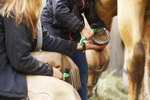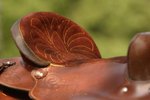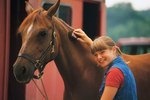Things You'll Need
Nippers
Rasp
Hoof knife
Farrier's apron
Hoof pick
Tips
If you're unsure whether to cut or rasp away more hoof, it's better to err on the side of caution. A little too much hoof is much less painful and uncomfortable than too little hoof.
Donkey hooves are almost the same composition as horse hooves, but they're much more dense. Fortunately for those who own donkeys and horses, trimming a donkey's hooves is done almost the same way as trimming a horse's hooves. The only difference is the size of the animal and the angle at which the hooves are trimmed. If a donkey's hoof hasn't been trimmed in a long time, it might start to curl, and that can take time to correct.
Tie the donkey securely and relax it. A light brushing and establishing that it's time to clean the hooves is a good thing to do. A donkey's hooves should be trimmed every six to eight weeks, according to Tiny Farm Blog.
Take the hoof firmly in hand and clean it. Brush off dust and grit, and use a hoof pick to pull out any dirt or grit that's gotten into the hoof's sole. Use a hoof knife to scrape away the dead hoof material from the sole. Dead material is dry and flaky, whereas living hoof is springy. Use your fingers to judge if the hoof material you're trimming it dead or not.
Trim the curling hoof. A donkey's hoof should be trimmed at the same angle as its shoulders or hips, for the front and rear hoofs respectively. If a hoof has begun to curl, you need to take farrier's nippers, which are like industrial nail clippers, and begin clipping the nail. Grip the nippers with one hand on each handle, and keep the nipper blades perpendicular to the angle of the hook and not to the angle of the hoof wall. It's recommended that you never clip more than half the length your nippers can handle at once. As with the sole, dead hoof material is dry and hard; living hoof is softer and more flexible.
Use a rasp to clean up the hoof and to smooth out the cuts. A rasp is essentially a huge nail file, and as you drag it over the hoof it rubs away harsh angles and smooths out the cuts you've made. The rasp can also damage your skin, so you may wish to wear gloves while using it.
References
Tips
- If you're unsure whether to cut or rasp away more hoof, it's better to err on the side of caution. A little too much hoof is much less painful and uncomfortable than too little hoof.
Photo Credits
-
Jupiterimages/Brand X Pictures/Getty Images
Writer Bio
Neal Litherland is an author, blogger and occasional ghostwriter. His experience includes comics, role playing games and a variety of other projects as well. He holds a bachelor's degree in criminal justice from Indiana University, and resides in Northwest Indiana.




